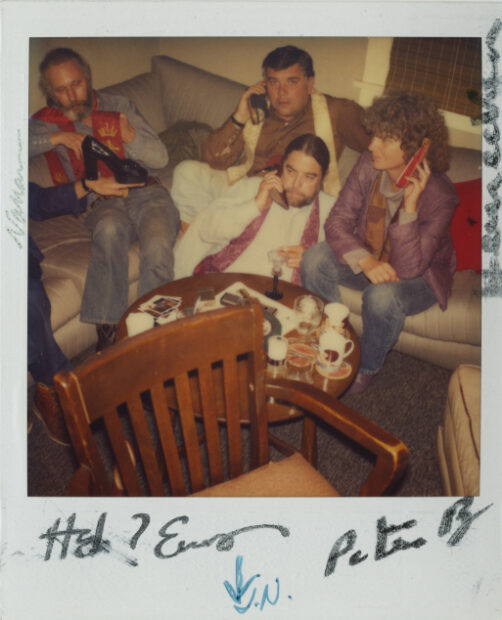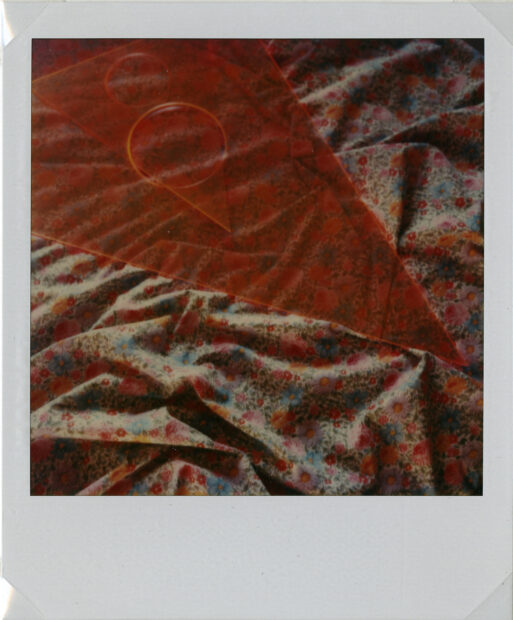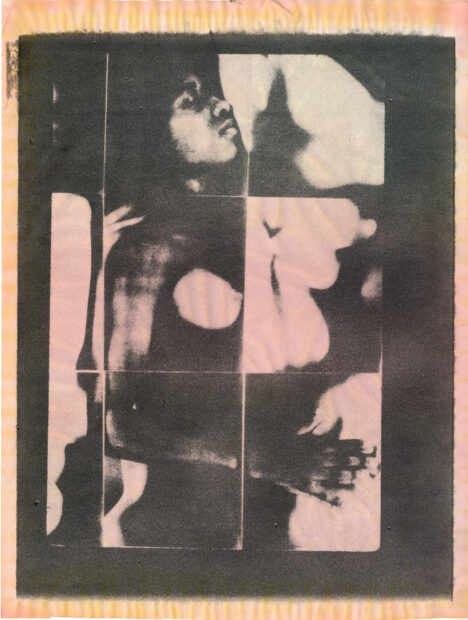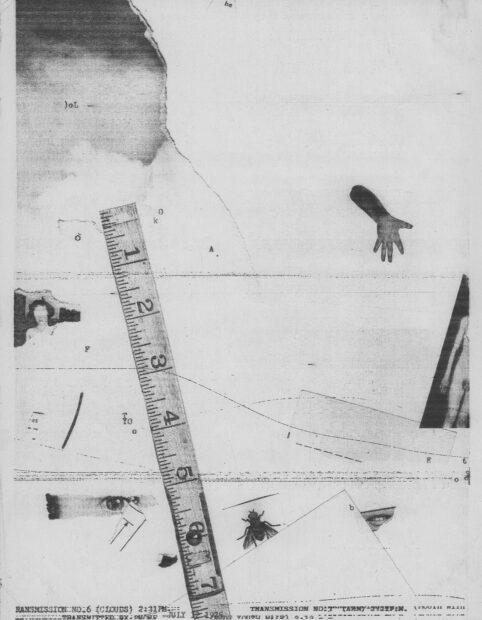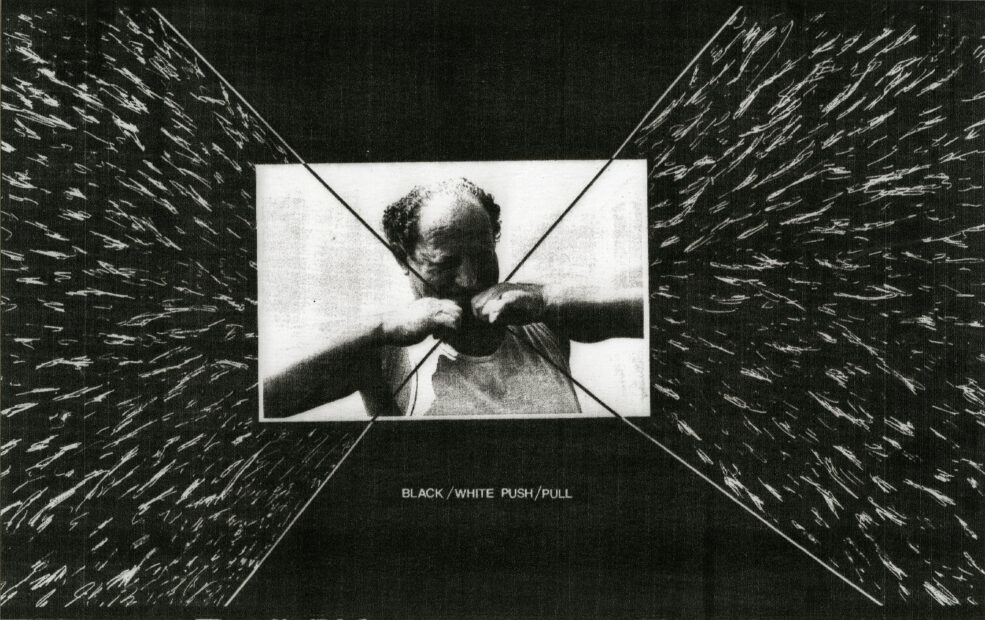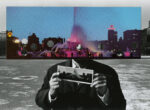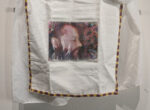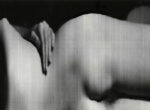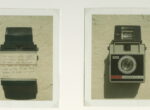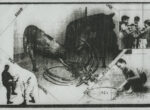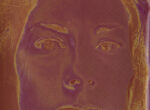-
500.022.3.23
- 500.021.3.22
- 046.A2064.3.15
- 046.927.3.09_new
- 046.633.3.09_new
- 046.519.3.08_new
- 046.301.3.08_new
 Kenneth Josephson
Kenneth Josephson
Southern, U.S. 1972 (Collage), 1972Gelatin silver photograph and postcard collage mounted to board. 1972 collage. Titled, dated, signed, numbered '1/8' and annotated '#72-35-31-25' in pencil by artist on mount verso. 3 5/8 x 5 11/16 in. (9.21 x 14.45 cm)Contact For Pricing & Availability 046.359.3.08_new- 046.522.3.08_new
- 880.001.1.23
- 880.002.3.23
 Sonia Sheridan
Sonia Sheridan
Untitled (portrait of Sonia Sheridan), March 20, 1974Mixed media telecopier collage. 1974 print. 3 piece layered collage to Annotated top left "3.20.74 VSW," top right "Sheridan talking about I.L." , left bottom "#6", and right bottom "6". 11 5/8 x 8 1/2 in. (29.5 x 21.6 cm)Contact For Pricing & Availability 880.004.3.23- 880.008.3.23
- 880.014.3.23
- 880.009.3.23
- 880.010.3.23
- 880.011.3.23
- 267.539.3.14
- 267.558.3.15
- 267.078.3.10
- 267.556.3.15
 Charles Swedlund
Charles Swedlund
Photographic Cube Puzzle, (Plus Six Prints), 1974Gelatin silver photograph. 1974 print. The Photographic Cube Puzzle consists of 49 one-inch square pieces of wood (cubes). Cubes have six sides, producing a total of 295 surfaces. Each cube has a one-inch square section of a photograph of a figure. 7 3/8 x 7 3/8 x 3/4 in. (18.7 x 18.7 x 1.9 cm)Contact For Pricing & Availability 425.011.3.23- 425.050.3.23
- 470.024.3.23
- 470.023.3.23
- 470.026.3.23
- 470.028.3.23
 William Larson
William Larson
Figure in Motion, 1966-68Gelatin silver photograph. c. late 1960s print. From "The Human Figure in Motion", Portfolio 1, 1968. Mounted on 14x11 in. Strathmore mat board. Signed in ink on label with numbered PLATE 12 label on mount verso. 1 11/16 x 9 1/2 in. (4.3 x 24.1 cm)Contact For Pricing & Availability 470.027.3.23 William Larson
William Larson
Figure in Motion, 1966-68Gelatin silver photograph. c. late 1960s print. From "The Human Figure in Motion", Portfolio 1, 1968. Mounted on 14x11 in. 4 ply mat board. Signed in ink on label with Locust Avenue address stamp and typed Portfolio 1 label on mount verso. 1 13/16 x 9 9/16 in. (4.6 x 24.3 cm)Contact For Pricing & Availability 470.032.3.23 William Larson
William Larson
Figure in Motion, 1966-68Gelatin silver photograph. c. late 1960s print. From "The Human Figure in Motion", Portfolio 1, 1968. Mounted on 14x11 in. mat board. Signed in ink on label with PLATE 3 label on mount verso. 1 13/16 x 9 11/16 in. (4.6 x 24.6 cm)Contact For Pricing & Availability 025.730.3.23- 025.666.3.13
 Barbara Crane
Barbara Crane
Tucson Portfolio II, Spring, 1980Portfolio from a limited edition of 35 of which this is number 2. Eight Polacolor pairs photographs on mount. 1980 prints. Signed, titled, dated, editioned and numbered in gold ink by artist on mount margin recto. 4 7/16 x 3 1/2 in. (11.27 x 8.89 cm)Contact For Pricing & Availability 890.004.1.24- 890.001.1.24
- 890.002.1.24
- 890.003.1.24
- 657.057.3.23
- 657.112.3.23
- 657.053.3.23
- 657.030.3.23
Medium as Message: Generative and Experimental Works from the Chicago School
It was an era of new and exciting technological advances in the world of image transfer and creation. From the late 1960s to the 1980s newly developed electronic information and communication systems were at the forefront of these advances and not yet a part of everyday life. The fax machine, copier machine, both in-color and black-and-white had been developed and the possibilities for utilization had only been touched upon by this point. The Brands that created them knew they would be valuable to commercial enterprise, however, many sought out artists, knowing that they could propel product’s usefulness experimenting with them in ways unimagined.
Generative Systems, was a program founded in 1969 at the Art Institute of Chicago and headed by the pioneering artist and educator Sonya Landy Sheridan. At this laboratory she and her team which included faculty and students alike, delved into the possibilities of electronic image production, well before the digital age. They researched the prospects of the machine as art generator. It was all trough close contact and sponsorships of companies like Xerox and 3M that enabled this group to produce and advance the medium so quickly and efficiently.
“It is obvious that this work process becomes another kind of time for the artist as the distance from conception to conception is reduced to minutes, and objects change as rapidly as thinking allows.”
–Sonia Landy Sheridan
Chicago’s Columbia College also offered a Generative Systems program, and hired Peter Thompson to spearhead it in 1978. They made use of many similar technologies. Given the accelerated feedback loop – each new technique as they were discovered could be carried out and thoroughly investigated. In both Columbia’s and the AIC programs there was a certain emphasis on semi-regular periodical (Yony at AIC), zines, and one-of-a-kind book making. Imagery itself included that of noise, and instant image production such as direct photo copier art (often faces or body parts), and collage, influenced no doubt by Word Art of the 1960s and earlier Dada works.
Other experimenters at the time, many of whom were graduates of the Institute of Design, pushed the boundaries within more-traditional techniques, though presenting in new and often amusing fashions. Two artists that employed their understanding of off-set photo-lithography to create multiple copies, as well as new and unique processes were Charles Swedlund and Robert Heinecken. Others, including Swedlund and Barbara Blondeau, refined photo-processes such as fiber-based color printing, and the Kwik Print by Light Impressions, created vivid, graphic works of art. And when access to new platforms became more widely available many obtained equipment, like William Larson, who got a DEX-1 Teleprinter enabling him to produce his incredible Facsimile Transmissions.
The Nude and self-portrait as subjects were a mainstay for the artists, who were often working in controlled or studio environments. This may have been part reason for the choice, but also access, and the additional reason—simply a product of the free-spirited times. Unaware that each were doing the same, Blondeau and Larson developed mechanized means to make their panoramic “in-camera” multiple imagery of the nude, and Heinecken and Swedlund, made silver printed 3d puzzles. And at-times working in tandem, Sonia Sheridan and Keith Smith (who was a graduate of AIC and ID, and later a colleague of Sheridan) photo-copied, and re-copied or re-presented their nudes. Both utilized image on fabric, and Smith’s further exploitations included stitching and collaging to textiles.
Polaroid instant film was also gaining notoriety during this time. Polaroid, as a company often distributed its film lines among artists both as a word of mouth promotional tool, but also to find out more about their own technology. Kenneth Josephson and Barbara Crane both had enduring relationships with the instant film in multiple formats.
On view in this exhibition are over forty examples of exploratory and process-oriented works of art. Each piece is unique in its objectivity toward the subject, and in recognition of the medium—touching upon the myriad of ways art production was manipulated, multiplied, and electro-mechanized—highlighting a slice of the artists who were key to the beginning of the electronic age of photography.
Exhibition Date
February 9th - May 3rdReception Time
Friday, February 9th 2024, 5-8pm- William Larson
- Robert Heinecken
- Kenneth Josephson
- Charles Swedlund
- Barbara Crane
Represented Artists
- Sonia Landy Sheridan
- Keith Smith
- David Smith
- Barbara Blondeau


